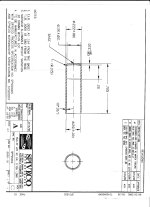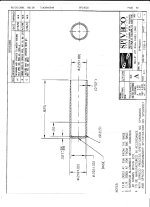jackie schmidt
New member
One of the byproducts of the Tomball Gun Club being shut down for renovation and matches being canceled because of Covid is we all have time to sit around and REALLY confuse our minds with ideas and experiments.
One I have been playing around with is bullet core seating.
It is understood that when core seating, you want to arrive and the proper diameter of the cored jacket, the proper amount of core pressure, and the “just right” amount of lead bleed by at the punch.
The last one really bugs me. Ideally, it would seem that the least amount of bleed by while getting the first two right would be ideal.
Here is what I am running into. I open a new lot of jackets, and through trial and error, arrive at the correct punch size and core seating pressure. You start seating cores, and then jackets start staying on the punch. You check for lead buildup on the punch. None. With a magnifier, you look in the jacket to see uneven lead bleed by and on some, evidence that the punch is too tight. You try a .0005 smaller punch. The bleed by is excessive. You go back to the othe punch, and find that 2/3 of the core seated jackets are perfect, but 1/3 are terrible. Sticking to the punch, uneven lead bleed by, etc.
What he heck is going on.
The answer. Inconsistent jacket wall thickness. So I made a little rig with a “tenth” indicator to see if I could accurately ascertain the wall thickness variations in a bucket of jackets. This is no easy task considering the taper inside the jacket.
What I found is disturbing. The best jackets are running .0002 or better in wall thickness variation. But at least 1/3 of those tested are showing as much as .0004 to .0005 variation.
When test coring these up, these are the ones getting irregular bleed by and sticking to the punch.
We are trying to make top quality Benchrest quality bullets. It all starts with the jacket.
I am a little disappointed in the quality of the 15,000 I have on hand. I guess the next step is to physically check every jacket for wall consistency.
Or just say to heck with it.
My thoughts on this are any irregular lead bleed by in the core seated jacket will be very detrimental to the balance of the spinning bullet, and of course, accuracy.
One I have been playing around with is bullet core seating.
It is understood that when core seating, you want to arrive and the proper diameter of the cored jacket, the proper amount of core pressure, and the “just right” amount of lead bleed by at the punch.
The last one really bugs me. Ideally, it would seem that the least amount of bleed by while getting the first two right would be ideal.
Here is what I am running into. I open a new lot of jackets, and through trial and error, arrive at the correct punch size and core seating pressure. You start seating cores, and then jackets start staying on the punch. You check for lead buildup on the punch. None. With a magnifier, you look in the jacket to see uneven lead bleed by and on some, evidence that the punch is too tight. You try a .0005 smaller punch. The bleed by is excessive. You go back to the othe punch, and find that 2/3 of the core seated jackets are perfect, but 1/3 are terrible. Sticking to the punch, uneven lead bleed by, etc.
What he heck is going on.
The answer. Inconsistent jacket wall thickness. So I made a little rig with a “tenth” indicator to see if I could accurately ascertain the wall thickness variations in a bucket of jackets. This is no easy task considering the taper inside the jacket.
What I found is disturbing. The best jackets are running .0002 or better in wall thickness variation. But at least 1/3 of those tested are showing as much as .0004 to .0005 variation.
When test coring these up, these are the ones getting irregular bleed by and sticking to the punch.
We are trying to make top quality Benchrest quality bullets. It all starts with the jacket.
I am a little disappointed in the quality of the 15,000 I have on hand. I guess the next step is to physically check every jacket for wall consistency.
Or just say to heck with it.
My thoughts on this are any irregular lead bleed by in the core seated jacket will be very detrimental to the balance of the spinning bullet, and of course, accuracy.
Last edited:





